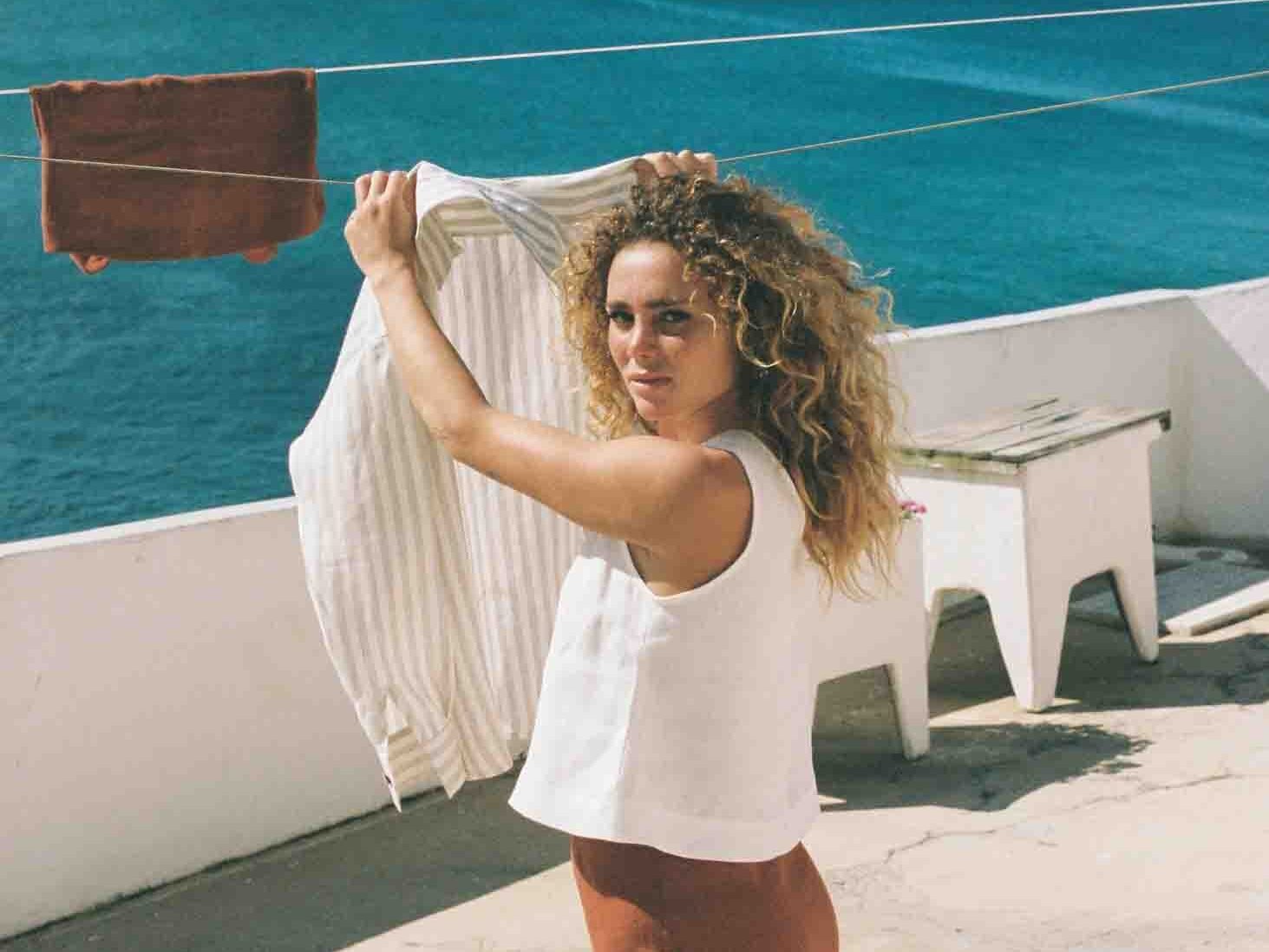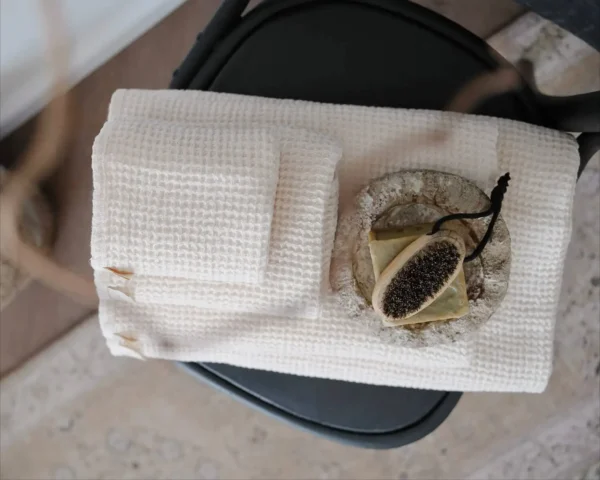
Linen care guide. Tips & tricks
Linen
You probably know that linen has been used for centuries in the production of various items: canvases, wallpapers, bedding and, of course, clothes. Today, linen is one of the most appreciated materials in the world by people who value naturalness, healthy lifestyle and comfort. To better understand why linen is in the continuous process of becoming more and more popular worldwide, you can read our blog about linen advantages.
Linen care guide
Taking proper care of linen items
Linen fabric is known for its breathability, hypoallergenic characteristics, durability, and natural elegance. Taking care of linen is not as difficult as it may seem. Below are some simple and easy care guidelines to keep your linen items in great condition and lasting for a long time.
Hand Washing – Linen products may be washed by hand or by a washing machine. Hand washing is ideal for lightly soiled clothes or fine linens that require a more delicate touch.
Machine Washing – We recommend washing your garments in cold or lukewarm 30°C / 86 °F water (temperature could be increased up to 40°C / 100 °F or 60 °C / 140 °F if heavy stains appear. However, you have to keep in mind that high temperature could cause shrinkage and weaken the linen fiber).
Wash separately from another laundry, using a bleach-free laundry detergent. Best to use mild detergent formulated for delicate fabrics. Do not launder dark and light fabrics together. If you are washing clothes with a washing machine, use the gentle machine cycle and do not overload it so the fabric can move freely. Otherwise, it might crease or become stripy.
Bleaching should be avoided as it weakens fabric structure. However, if necessary, it should only be used strictly on white linens. Instead of bleach, you can use stain remover treatments before washing your laundry if needed.
Drying – It can be dried in natural conditions or in a dryer with a gentle care program (delicate) and low temperature. If possible, we always recommend choosing the natural way of drying. Washed and gently wrung fabric has to dry while hung so the water can run down. The fabric can also be laid horizontally. Note that linen dries very quickly, so it is important not to over-dry it in the sun. It makes the fabric more difficult to iron afterward. If the products are being dried in the dryer, they must be taken out while still humid.
Ironing – Linen is naturally wrinkly, and that is one of the most beautiful features of it since it reveals its naturalness. Wrinkles of linen represent its authenticity and quality. We recommend not to iron linen clothes in order to maintain softness and fluff. However, if you still want to iron your linen products, do it at a low temperature while it is still a little humid. It will iron better, and there will not be any need to wet it while doing so. Otherwise, (if you have) steam iron is the best option. Iron it from the inside out. This way, the surface of linen will be protected from gloss and decoloring.
The storage of linen – Before storing, make sure that the products are completely dry! It is best to keep linen products in a dry and cool room, away from direct sunlight. We recommend keeping them out of plastic bags! From time to time, let the fabric stay in a well-ventilated space. After every wash, linen fabric becomes softer and less likely to wrinkle.
How to remove stains from your linen garments and Home Textile
Stay Calm& Carry On. We’ve got you covered!
Life is a beautiful tapestry woven from countless experiences, both planned and unexpected. It’s in the little moments—the laughter shared with friends, the warmth of the sun on your face, the joy of an impromptu adventure that we find true happiness. Alongside these joyful instances come life’s inevitable mishaps, like spilling coffee on your favorite shirt or getting mud on your new dress. These minor accidents are a part of the rich, colorful narrative of our daily lives. Understanding how to take care of such events allows us to navigate life with grace and maintain our joy despite the occasional stain. The good news is that the stains come out easier on the linen fabric than any other! Here are a few tips and tricks to handle those everyday stains, ensuring that your garments stay as vibrant as the moments you cherish.
General tips
- The main rule is to act quickly. Time is not your friend in this situation, as any stain becomes increasingly challenging to clean over time.
- Always test. Before applying any treatment to the stain, make sure it works on a small, hidden section of your garment in order to avoid damage or discoloration to your linens.
- Do not scrub stains. To prevent making the stain worse by pushing it deeper into the material, you should gently blot the stain with a clean cloth or paper towel. If the stain is tough, you can try gently rubbing at it, but be careful not to damage the material. Blotting helps lift the stain without spreading it further.
- Don’t use bleach. Bleaching should be avoided as it weakens fabric structure. However, if necessary, it should only be used strictly on white linens and preferably oxygen bleach rather than chlorine bleach.
- Small stain. If you notice a small stain, try soaking it in a water-detergent solution or washing it with club soda.
- Professional cleaning. Sometimes, for tough or delicate stains, professional cleaning is needed to avoid damaging the fabric.
How to remove various stains from linen fabric
- Red wine stains – blot the stain with a clean cloth to absorb as much wine as possible. Sprinkle salt all over the stain to absorb the wine. Wait till the salt dries out. Rinse with cold water and wash as usual.
- Coffee stains – blot the stain with a clean cloth to absorb as much coffee as possible. Mix a solution of equal parts – one tablespoon of vinegar, dishwashing soap, and water, apply to the stain, and then blot again. Wash as usual.
- Tomato sauce stains – blot the stain with a clean cloth to absorb as much sauce as possible. Apply a mixture of baking soda and water to the stain, allowing it to sit, then rinse and wash as usual.
- Grease stains – Blot the grease stain with a paper towel. Apply liquid mild dish soap directly to the stain, let it sit for a few minutes, then rinse with warm water and wash as usual.
- Berry stains – As we said earlier, the main rule is to act quickly. Turn your garment inside out. The stain should go out of the fabric, not deeper into it. First, rinse the stain using cold water. Second, pour boiling water on the stain as soon as possible. The best and safest way to do this is to stretch the fabric over the bowl and secure it with a rubber band to keep the garment in place. Repeat until the stain is removed. After this, if needed, you can wash your garment as usual.
- Soft beverage stains – blot the stain with a clean cloth or paper towel to absorb as many beverages as possible. Turn your garment inside out. The stain should go out of the fabric, not deeper into it. Rinse the stain with cold water, and after that, soak the linen in cold water for 10 minutes. If the stain remains, apply liquid mild dish soap directly to the stain, let it sit for a few minutes, then rinse with warm water and wash as usual.
- Grass stains – Turn your garment inside out. The stain should go out of the fabric, not deeper into it. To remove a grass stain, first rinse the stained area with cold water. Then, apply a small amount of liquid mild laundry detergent directly to the stain. Gently rub the fabric together or use a soft-bristled brush to work the detergent into the stain. Let it sit for about 5-10 minutes. Afterward, rinse the fabric once more with cold water. If necessary, you can use mild dish soap as you would with laundry detergent.
Final Thoughts

Life’s beauty lies not in perfection but in the richness of experiences and the resilience to handle its messes with grace. Every stain tells a story. A spilled drink at a joyous celebration, a splash of mud from a spontaneous outdoor adventure, or a smudge from a hug filled with love. Embrace these moments, for they are the essence of a life well-lived. With these tips and tricks above, you can take care of your garments and continue to celebrate the vibrant, messy, and beautiful journey of everyday living.
Free linen scraps for your testing purposes!
We know that trying different cleaning methods on your beloved clothes can be daunting, and you might not want to risk damaging them. That’s why we’ve included a piece of linen fabric leftover from our production, so you can test out what works best for you without worry! This approach aligns with our commitment to sustainability and conscious garment production, ensuring almost zero wastage. We hope that by using the provided piece of linen fabric, you can confidently try out these methods and find what works best for you. Our dedication to sustainability and minimal waste ensures that every piece of fabric is valued, just as every moment in life should be.
Like this blog? Join our newsletter and get 10% off on your first order. By joining, you’ll be the first to know about our latest updates, blogs, special offers, and industry insights. We promise not to spam your inbox!
Join our community for the latest updates, trends, and inspiration on linen home textiles and lifestyle.
Recent articles
- The Ultimate Guide to Unique Christmas Gift IdeasThe Ultimate Guide to Unique Christmas Gift Ideas The holiday season is coming, and with it comes…
- Personalized Gifts – Perfect Choice for Every OccasionPersonalized Gifts – Perfect Choice for Every Occasion For those who value quality, uniqueness, and sustainability, personalized…
- The Magic of Linen TowelsThe Magic of Linen Towels When it comes to selecting the perfect towels for your home, the…




2 Comments. Leave new
This was incredibly helpful. Thank you!
You are most welcome, I’m glad you found it helpful! 🤍